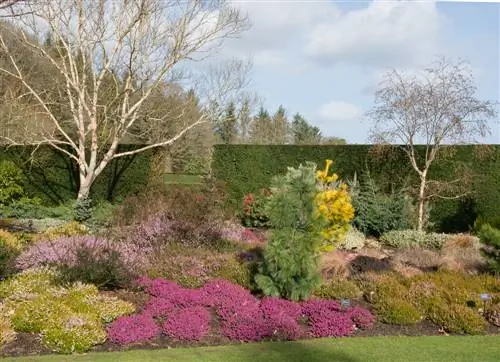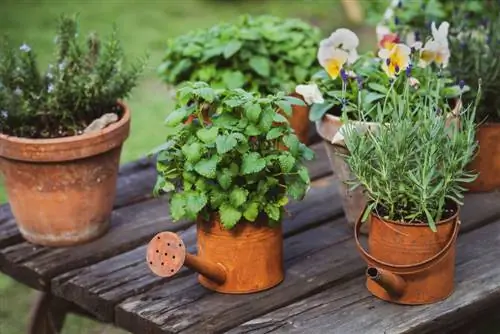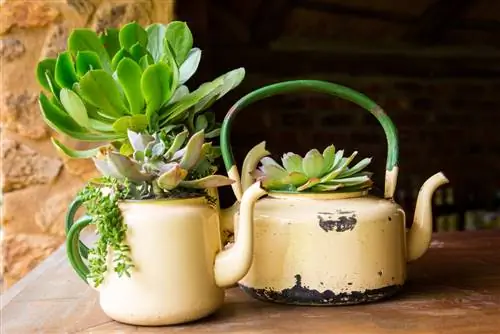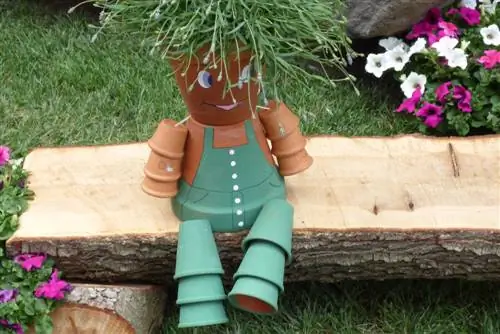- Author admin [email protected].
- Public 2023-12-16 16:46.
- Last modified 2025-06-01 06:02.
Read a commented blood maple profile here with explanations of decorative growth. Short instructions with tips and tricks explain how to properly plant, care for and cut Acer platanoides Faassen’s Black.
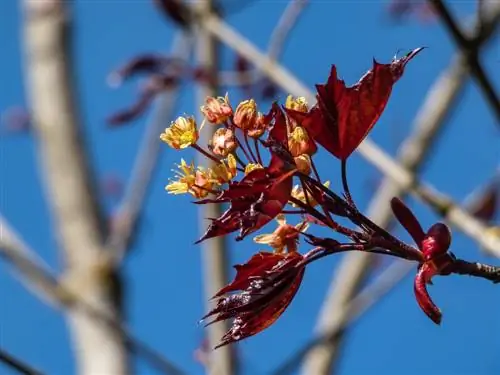
What are the characteristics of the blood maple 'Faassen's Black'?
The blood maple 'Faassen's Black' is a deciduous tree with deep red leaves and a height of 10-15 m. It is suitable as a representative house tree and is characterized by its winter hardiness, drought resistance and location tolerance. The leaves are bright red when budding and black-red to dark purple in summer.
Profile
- Scientific name: Acer platanoides ‘Faassen’s Black’
- Breeding form of the species: Norway maple (Acer platanoides)
- Genus: Maples (Acer)
- Family: Sapindaceae
- Growth type: deciduous deciduous tree
- Growth height: 10 m to 15 m
- Leaf: lobed
- Flower: umbel
- Fruit: Split Fruit
- Roots: Heartroots
- Winter hardiness: hardy
- Use: Single position, house tree
Growth
Blood maple 'Faassen's Black' is a magnificent deciduous tree with deep red, shiny leaves. The progenitor is the native Norway maple (Acer platanoides). It is a chance cross between Acer platanoides 'Schwedleri' and Acer platanoides 'Reitenbachii', which occurred at the beginning of the 20th century. Century was discovered. Its high esteem as a representative house tree is based on these key growth data:
- Growth habit: upright standard trunk with broad, spherical crown, intensely colored, black-red foliage.
- Growth height: 10 m to 15 m.
- Growth width: 6 m to 10 m.
- Root system: flat heart sink system with pronounced lateral roots and fine roots in the upper horizontal area.
- Growth rate: 30 cm to 60 cm annual growth.
- Gardenically interesting properties: hardy, easy to care for, non-toxic, sensitive to cutting, drought-resistant, heat-tolerant, location-tolerant.
Leaf
Its shapely growth combines a blood maple with these remarkable leaves:
- Leaf shape: petiolate, palmately lobed (3 to 5 lobes, pointed lobes).
- Coloring: bright red shoots, black-red in summer, wine-red to dark purple, shiny metallic on top, bronze-red-brown in autumn.
Video: Admire blood maple leaves up close
Bloom
At the start of the season, the deciduous deciduous tree delights with a decorative play of colors. The bright red leaf shoots are accompanied by pretty flowers with these characteristics:
- Inflorescence: umbelliferous in dense clusters.
- Flower color: purple bracts, yellow stamens.
- Flowering time: April to May.
- Flower ecology: incompletely dioecious gender distribution with both hermaphrodite and male or female flowers.
- Pollinators: wild bees, honey bees, bumblebees, butterflies.
The early flowering period and a remarkable nectar value of 3 make blood maple 'Faassen's Black' a valuable bee pasture for the natural garden.
Excursus
Mini blood maple for front garden and balcony
Hobby gardeners with a lack of space plant a small blood maple. Japanese blood maple Acer palmatum 'Red Emperor' remains at a height of 2 m to 3 m and is just as wide. The Asian maple tree's upright, vase-shaped shape is covered in deep, dark red foliage. The blood-red favorite for balcony gardeners is the pot-suitable variety Acer palmatum 'Garnet' with a growth height and width of 100 cm to 150 cm.
Planting blood maple
The best planting time for Acer platanoides 'Faassen's Black' is in autumn. At this time of year you can buy the most beautiful specimens at the tree nursery as inexpensive Heister or ready-to-plant standard trees. Proper planting takes into account the special growth of the roots. This is how to plant blood maple correctly in the garden:
Location
Faassen's Black inherited its tolerant location tolerance from its ancestor Norway Maple. These are the ideal conditions for a blood maple in the garden:
- Sun to partial shade.
- Normal garden soil, permeable, fresh, moist and rich in nutrients.
- Exclusion criteria: full shade, acidic ericaceous soil with pH value less than 5, waterlogging.
Planting - quick guide
Good soil preparation, the use of a root barrier and well-considered planting spacing are important aspects in the correct planting process. The following step-by-step instructions briefly explain how to properly plant a blood maple:
- Dig a spacious planting pit with enough space for the root ball.
- Cover the bottom of the pit a few centimeters high with lava mulch, sand or grit as drainage.
- Mix one third of the excavated material with compost and horn shavings.
- Line the planting hole with a rhizome barrier.
- Plant the blood maple as deeply as before in the nursery (soil mark on the trunk).
- Drive in a support post or tripod and connect it to the tree trunk to protect against wind throw.
- Tamp down the earth and muddy it up.
For blood maple, the legally required planting distance from the property line is often not sufficient. The optimal distance to neighbors, to the street and to masonry is at least half the expected growth width, i.e. 3 m to 5 m.
Care for blood maple
In the right location, a blood maple is very easy to care for. The regular water and nutrient supply takes the shallow root system into account. Pruning is only necessary if necessary. A change of location is possible in the first few years. Diseases and pests that occur are easy to combat using natural means. This is how you care for a blood maple in an exemplary manner:
Pouring
In a sunny to partially shaded location, a blood maple evaporates a lot of moisture through its dense leaves. If there is warm wind, watering is necessary several times a week in summer. Use a finger test to determine in advance whether the soil is actually dry. It is better to water thoroughly twice a week rather than in small amounts every day. This approach increases root growth in depth and improves stability.
Fertilize
How to properly fertilize a blood maple:
- Best time is in March/April.
- Sprinkle 3 to 5 liters of compost and 100 grams of horn shavings per m² on the tree disc.
- Incorporate fertilizer and rain in.
Cutting
Its spherical crown forms a blood maple without a topiary. In any case, every pruning is accompanied by a strong flow of sap. How to cut Acer platanoides Faassen’s Black correctly:
- Rule of thumb: only cut blood maple when necessary.
- The best time to cut is in autumn because the sap pressure is lowest after the leaves have fallen.
- Cut back excessively long branches that protrude from the crown shape, thin out dead branches.
- Pruning is limited to one- and two-year-old wood.
- Important: Do not apply tree wax to bleeding cuts or only apply a thin layer of tree wax to the edges.
Transplanting
You can transplant a maple tree within the first four to five years of existence. With each additional year, the probability of failure increases. The best time is during the leafless period. Pruning is mandatory to compensate for the lost root mass. This approach has proven itself well in hobby gardening:
- Transplanting blood maple in autumn.
- Cut the root disc in the diameter of the crown with a spade.
- Lifting a tree out of the ground.
- Place the root ball with as much soil as possible in a jute bag.
- Plant as deep as before in the new location.
- Cut back all shoots by a third.
- Form the pouring edge and coat it.
Propagation
Propagate blood maple in the hobby garden is difficult. When sowing seeds, one parent usually prevails, so that a completely different maple tree grows than hoped for. Cuttings and cuttings generally do not root. In the nursery, Acer platanoides Faassen’s Black is propagated by inoculation. This is a demanding propagation method that requires hobby gardeners to have the know-how of a master nurseryman.
Diseases, pests
Although planting in the garden is a home game for the Norway maple descendant, various diseases and a voracious pest lurk. The following table describes common damage patterns on the blood maple, lists the causes of the infestation and gives tips for effective countermeasures:
| malicious image | Cause/Infestation | Countermeasure |
|---|---|---|
| Floury-white, wipeable leaf coating | Mildew (Erysiphales) | remove affected leaves, spray diluted milk |
| Black leaf spots with yellow edges | Tar spot disease (Rhytisma acerinum) | destroy infected leaves |
| Vermilion red pustules, bark discoloration | Red pustule disease (Nectria cinnabrina) | Pruning into he althy wood |
| Withered leaves, dying shoots | Verticillium wilt (Verticillium) | Clearing, soil exchange |
| Leaf damage, bald damage | Great Frost Moth (Erannis defoliaria) | Glue rings, neem, caterpillar glue |
Popular varieties
More beautiful blood maple varieties can be discovered in tree nurseries and garden centers:
- Acer Crimson Sentry: garden-suitable blood maple, columnar crown, dark red foliage, yellow-orange autumn leaves, height 6-10 m.
- Acer platanoides Crimson King: weak-growing blood maple, bright blood-red leaves, golden yellow autumn color, growth height up to 15 m.
- Royal Red: large cone-shaped tree, red shoots, purple summer leaves, bright red color in autumn, 12-15 m high, 6-8 m wide.
FAQ
We would like to buy a blood maple. Is Faassen’s Black suitable as a house tree?
Blood maple Faassen's Black grows as a medium-strong deciduous tree with a broadly conical to rounded crown. Purple-yellow flowers appear in April at the same time as the bright red leaves emerge. The foliage impresses with its deep red, shiny color and falls off after the bronze-red autumn color. As a standard tree, the tree reaches a height of 15 meters and is around 10 meters wide. The annual growth is 30 to 60 centimeters. The native Norway maple variety thrives in a sunny to partially shaded location in any normal garden soil, but fails on boggy, acidic, peaty soils. The majority of its root system is located in the upper horizontal area, so planting with a rhizome barrier is advisable.
My blood maple suffers from white leaf spots with blurred edges in summer. Is that mildew?
According to your description, it is not powdery mildew, but leaf bleaching caused by too much sun. This is indicated by light spots with contourless edges on the black-red foliage. As the disease progresses, these leaf spots turn brown and dry out. To prevent the sunburn from getting worse, please do not sprinkle the crown with water in direct sunlight.
My blood maple standard tree sheds its curled leaves in the middle of summer. What to do?
Shedding leaves with curled leaves is a typical symptom of water shortage. Please form a small earth bank on the tree disc as a casting ring. Water thoroughly in the following days. For a fully grown blood maple, the garden hose should run for at least 20 minutes. The deciduous tree should recover within one to two weeks. Especially in sunny, windy locations, the deciduous tree suffers from extreme evaporation, so it rolls up its leaves for protection or, in the worst case, sheds them.
Our 4-year-old blood maple forms long whip shoots. When is the best time for a cut?
Fall is the best time to prune a Faassen’s Black blood maple. At this time of year the sap pressure is reduced so that the tree rarely bleeds from cuts. Please use freshly sharpened, disinfected tools. Protect yourself from the sticky plant sap with gloves and suitable clothing.


